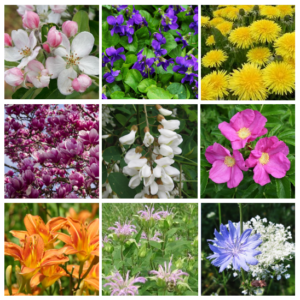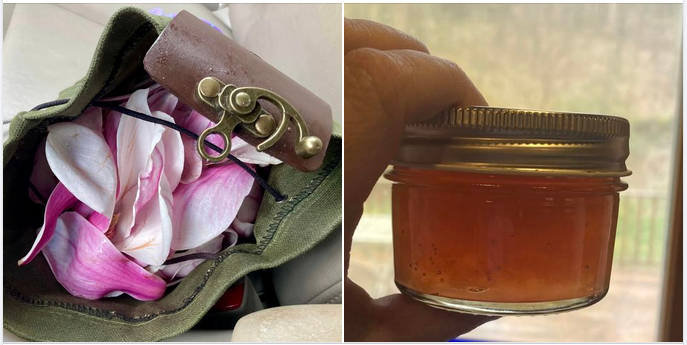So, it’s spring, it’s finally stopped raining at my house (for now), and the violets and dandelions are popping up all over my yard. And THAT means it’s flower jelly time!
You can make jelly out of any edible flower that hasn’t been treated with chemicals. Pick early in the morning if you can, preferably NOT just after a rain. Be sure to leave some for the bees! You want just the heads, not any of the stems. Violet and magnolia buds are okay, but you want fully open dandelions. For purely petal jellies like bee balm or apple blossom, make sure the petals are fresh and unbruised. When you bring them home, wash them well to remove any bugs that were hiding in there. If you can’t deal with them right away, get them in the fridge. Fair warning though, they don’t last long.
For most flower jellies, you just pick the petals off; violet and red clover jellies can use the entire blossom, as can umbrelled flowers such as elderflower or Queen Anne’s lace. Dandelions, of course, have to be difficult. You need to remove as much of the green part that holds the thin petals together as you can (it’s called a involucre), because it is bitter bitter bitter. Some dedicated souls spend hours separating the petals from the involucre by hand. I do not have this kind of patience, and use a pair of clean kitchen shears or a sharp knife to remove it. At this point you can freeze the petals — most flowers for jelly tolerate being put in the freezer surprisingly well.
An important thing about flower jellies is that they have very little acid and no natural pectin, so you have to prepare them differently that your normal fruit jellies. Basically, you make an infusion of the petals, kind of like a flower tea, and you use that in place of fruit juice.
To make basic flower petal infusions
Combine 2 cups *packed* flower petals with either 3 ¾ cups of boiling water and ¼ cup of lemon juice, or with 4 cups of boiling water and 1 tsp of food-grade citric acid. Allow that to ‘brew’ for 24 hours. Pour the mixture through a jelly bag or multiple layers of cheesecloth to strain out the flowers.
The lemon juice/citric acid is in there because for safe canning, the end product of flower infusion + pectin + sugar must have a pH lower than 4.6. This is non-negotiable. I strongly advise flower jelly makers to buy an inexpensive pH meter with automatic temperature compensation to test each batch before canning. If the pH is too high, add lemon juice or food-grade citric acid until an appropriate pH is reached. Seriously, you don’t want to poison your friends and family.
Basic Flower-Petal Jelly
For use with apple blossoms, dandelions, violets, magnolia petals, locust flowers, elderflower, rose petals, red clover, wild daylily, bee balm, Queen Anne’s lace, and chicory.
- 4 cups infusion
- 2 cups sugar
- 1/3 cup low sugar pectin (Sure-Jell and Ball both make a low-sugar pectin, and several companies sell it in bulk online.)
Be prepared for the jelly to take longer at a boil than you’re used to before it starts to gel. If it gets truly ridiculous you can add a little more pectin, but remember to recheck the pH if you do so. I usually get 10 four-ounce jars, plus or minus one.
Happy flower picking!




